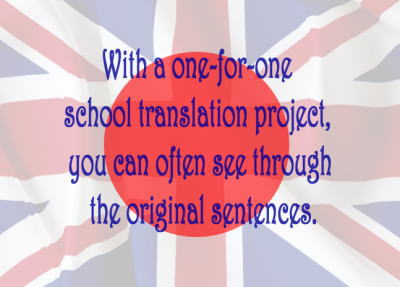Why Goody Translation Doesn’t Work?
Simply put, “goody translation” is a classroom assignment that will surely get an “A” mark but won’t necessarily be the correct answer in the practical world.
Then, what’s wrong with goody translation between English and Japanese? The primary culprit lies in the one-for-one conversion process that can inherit the source language’s peculiar characteristics, which are often unwanted because they make the target language writing unnatural and bizarre.
 We Aren’t in a Language Class. We Aren’t in a Language Class.
If you’re learning a language and working on a translation project, the teacher wants an academically correct composition. You need to transfer each word and sentence, one by one, into the target language. Don’t leave out anything. Don’t add anything. Don’t be inventive in any way. That’s a good translation and an effective way to test your language understanding.
However, school translation projects seldom make decent, real-world writing worthy of being published, particularly between English (or other European languages) and Japanese. As I said on the Home page, the gaps between Japanese and English are as vast as the seven seas.
Through the one-for-one translation process, you automatically import the source language’s sentence structures, logic, rhetorics, etc., all of which can impact target language expressions in negative ways. The more different are the two languages, the more serious the result is.
 You’re Going to Have to Trust Me for a Second. You’re Going to Have to Trust Me for a Second.
Those differences between English and Japanese I claim aren’t perceivable unless you have sufficient knowledge of the latter. So if it’s not the case, please trust and bear with me while I do a little experiment.
First, I’ll do a goody, school translation of some sentences, as shown below. Then, I rewrite them (if necessary) to make them more natural and relevant real-world writing.
Original sentences
- To be or not to be, that is the question. What must be, must be, that is the answer.
- John is not the brightest bulb and won’t win a popularity contest.
- We all know that constantly satisfying our customers' specific needs is challenging.
- Available in three different colors, those reversable caps are made using repurposed materials, that could end up in the landfill.
- Aim higher. Go further. Explore deeper. You can find us whenever you need. FreeEntity. Universally there.
|

|
Academically-correct, literal translation
- あるかないか、それが問題だ。ならなければならないことはならなければならない、それが答えだ。
- ジョンは最も明るい電球ではないし、人気コンテストには勝てないだろう。
- 私たちは皆、お客様の特定のニーズを常に満たすことは難しいことを知っています。
- 最終的に埋め立て処分されたかもしれない再利用素材を使用した、それらのリバーシブルキャップには3つの異なる色があります。
- もっと上を目指してください。さらに遠くへ行ってください。より深く探検してください。あなたは、必要なときにはいつでも私たちを見つけることができます。フリーエンティティ。普遍的にあります。
|

|
Adaptation for relevant, practical writing (Examples)
- あるかないか是か非か、それが問題だ。ならなければならないことはならなければならない結局はなるようにしかならない、それが答えだ。
- ジョンは最も明るい電球では決して頭は良くないし、人気コンテストには勝てないだろう人気があるわけでもない。
- 私たちは皆、お客様の特定のお客様の具体的なニーズを常に満たす満たし続けることは難しいことを知っていますです。
- 最終的に埋め立て処分されたかもしれない再利用廃棄処分になったかもしれない素材を使用再利用した、それらのリバーシブルキャップには。3つの異なる色がありますカラーバリエーションがあります。
- もっと上を目指してください。さらに遠くへ行ってください。より深く探検してください。あなたは、必要なときにはいつでも私たちを見つけることができます。フリーエンティティ。普遍的にあります。もっと高く、さらに遠くへ、より深く。いつもあなたのそばに。フリーエンティティ。その存在は普遍です。
Strikethrough: NG /
Red: Improvement
|
 Reasons Why I Don’t Accept the First Versions. Reasons Why I Don’t Accept the First Versions.
- Different grammar: Literal translation doesn’t make sense since Japanese have no grammatical structures or components as to-infinitive and prepositions.
- Different idioms or colloquial expressions: Literal translation doesn’t make sense since Japanese have no equivalent metaphors or figures of speech. Articulating their practical meanings is the only option.
- Wordy in Japanese: Rendering “We all know that” is academically correct but may sound wordy and tedious in Japanese. Besides, mentioning that part explicitly, in this case, sounds unnatural.
- Unnatural and unsmooth in Japanese: Long modifying clauses, which come before the noun, make the sentence hard-to-read, therefore, uncomfortable as a Japanese sentence. Modifying clauses should be concise or placed in another sentence.
- Immature Japanese writing: Literal translation of consecutive short sentences may end up sounding like a choppy, sloppy job or child’s homework.
 Conclusion: Goody Translation May Do More Harm Than Good. Conclusion: Goody Translation May Do More Harm Than Good.
As you see, A-student translation doesn’t make decent, practical writing. It’s pretty reasonable to remind you of the following tendencies:
- Many Japanese can tell whether they are reading a school project or an engaging elaborate piece. Thanks to their compulsory learning English at school, they can imagine what classroom composition would be like and separate it from practical, mature writing.
- Some sensible Japanese may not enjoy “translation smell.” Therefore, a completed piece needs to be convincing enough to make them feel as if it had been originally written in their language (even though it wasn’t).
- Cultural and historical differences (in addition to linguistic) often produce rhetorical, conceptual, and perceptual differences. Being faithful to the original sentence structures may not articulate what you really want to say.
Please refer to Differences Between English and Japanese if you’re interested in how exactly they are different.

Classroom translation doesn’t work.
|


 Reasons Why I Don’t Accept the First Versions.
Reasons Why I Don’t Accept the First Versions. Conclusion: Goody Translation May Do More Harm Than Good.
Conclusion: Goody Translation May Do More Harm Than Good.




